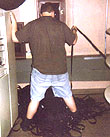|
|
This topic comprises 2 pages: 1 2
|
|
Author
|
Topic: Basic questions about focus
|
David Stambaugh
Film God

Posts: 4021
From: Eugene, Oregon
Registered: Jan 2002
|
 posted 01-15-2002 07:37 PM
posted 01-15-2002 07:37 PM





I searched all the forums on "focus", didn't come up with any discussions that really address my questions, but apologies in advance if this has been discussed and I just missed it or didn't look hard enough. Apologies also if these are dumb-ass questions.Here's the scenario: I see 2-3 movies a week, on opening weekend if possible. There are only 2 "modern" multiplexes in this area, so I've gotten to know them pretty well. I carry around a pretty good database of pros and cons about each location's screens in my head, so I can avoid the dogs and try to stick with the best. I go to a hypothetical movie, am pleased to find it being shown in a "good" theatre. The show starts, and it immediately looks "soft" to me. I wait for the trailers to finish and the feature to start, and it still looks soft. I try to evaluate whether it's me or some transient problem (aside from just being out of focus). After all, I've been here many times and the projection is usually very sharp. But I conclude it is indeed soft. I then approach someone on the staff. Might be a manager-type if I don't have to look too hard, or it might be the ticket-taker. I smile and say "I hate to whine, but the focus in Theatre [whatever] looks a little soft. Could you ask someone in the booth to see if they can improve it a little?" I don't make wild claims or accusations to put anyone on the defensive. The staff person smiles, says they will tell the booth. I thank them and return to my seat. What happens now is universally the same, every time: NOTHING. There is never any visible attempt that I can see that someone is attempting to optimize the focus. The show runs its full length looking soft to me. And nobody else complains (as far as I know). How do we explain this? Some possibilities: a) I could be imagining things. I don't think so.
b) The complaint never reaches the booth.
c) The complaint reaches the booth but is ignored.
d) The complaint reaches the booth but falls through the cracks because something else is going on up there.
e) The complaint reaches the booth. The person on duty looks out the glass and proclaims the image "good enough".
f) Longshot, but maybe the person on duty up there is forbidden from doing anything but starting the show? There may be other reasons. ? My questions boil down to this: 1) What is your standard procedure for focusing the show and keeping it sharp; and
2) What do you do if someone complains about the focus? I can't figure out why there wouldn't be a Booth Commandment that says "Manually focus every show whether you think it needs it or not". The next commandment might be "If a customer complains, make a show of focusing it [again], even if the result is no better, so everyone knows it's as good as it's going to get". Are the optics so stable that they can be focused and will then remain that way for a long time without attention? My theory is this is part of the explanation. If someone does a good focus, with a critical eye, it will probably be sharp for multiple shows, simply by default. Which breeds sloppiness about checking it later. OTOH, if they get it a little wrong, it's likely to stay that way for multiple shows because nobody is really looking at it critically. Talk amongst yourselves. (I'm home sick and have a lot of free time on my hands)
------------------
- dave
Crab juice, or Mountain Dew?
| IP: Logged
|
|
|
|
Will Kutler
Phenomenal Film Handler

Posts: 1506
From: Tucson, AZ, USA
Registered: Feb 2001
|
 posted 01-15-2002 08:21 PM
posted 01-15-2002 08:21 PM




There could be a variety of problems.I was strictly a projectionist at an all THX theater equipped with Christie projectors and Schnieder lenses. And we had our problems. All of the lenses were new. For some reason, the elements in many of the lenses (both flat and scope) loosened up to the point were focus could not be held and most lenses had to be sent in on rotation for repairs. It took a long time to get them back, and our theater chain had to exert some muscle to get prompt service. Can you imagine what a scheduling headache this was for us! Some of the early turret lock mechanisms on the Christie projectors did not hold the turret still and were a pain! This problem has been corrected with better parts/revised design. On one occasion, a patron threw a massive spit wad on the port window. I was quite busy and did not have enought time to go downstairs to correct the situation, so I asked one of the floor managers for help. This manager sent in a floor staff person who proceeded to knock off the spit wad with a filthy broom! Needless to say that the the window was badly smeared and the idiot also scratched it! What a pain it was to get clean! At this theater, the projection equipment and port windows were installed prior to the booth being painted! Needless to say, the windows and equipment have black overspray on them! This theater is largly used for promos. They even had the major film studios come in to run "unmarried" prints for audience feedback prior to final editing and release. Can you believe that the studio "tech" realigned our projector to the screen for their own purpose. And instead of cutting new plates, they masked the port window, rendering some damage! They did not even right things when they were finished! Luckily we were able to realign the equipment via the marks left in the flooring. I recently went into a theater to see a first run "scope" picture--a film that was supposed to be a blockbuster--but stunk! Anyhow, the picture was severly "cocked" on the screen--probably the result of an incorrectly installed "scope" lense. I complained to the theater management 3 times--hoping that they could correct it during the previews. Needless to say that they did not know how to correct the situation and were not interested in me assisting them with the adjustment! One of the managers even told me that the picture had been like that for at least 3 years--and their "tech" was aware of the situation! When focusing a picture between each show I cleaned and inspected both the port windows and lenses. The best way I found to inspect is to look at the surfaces on an angle with a flashlight. This definately highlights dirt and smears! When cleaning lenses, apply only a little solution to the tissue and lightly wipe in a circular spiral motion from the center out. Never apply solution directly to the lense! Kinda sorta the same wiping method used for cleaning reflector mirrors. Also, focusing itself must be done on a steady constant image--such as titles, greenbands or RP40--which can also be used to check lense resolution. One interesting topic that I have never heard discussed is lense fungus. Has anyone had this problem with projection lenses?
| IP: Logged
|
|
Joe Beres
Jedi Master Film Handler

Posts: 606
From: Minneapolis, MN, USA
Registered: Nov 2000
|
 posted 01-15-2002 08:22 PM
posted 01-15-2002 08:22 PM




David, there is (at least) one more possibility"g) poor quality labwork, and the print itself is soft it is somewhat rare, but it does happen, and you'll see here from time to time, that an entire run of prints, or certain reels of a certain film, can be bad, or that a particualr lab's work is notoriously shoddy. The unfortunate reality though is tied to you "e)," and that is: h) someone doesn't give a shit could be anyone from the person you told to the projectionist, but somewhere someone is keeping things from being fixed.
| IP: Logged
|
|
Jerry Chase
Phenomenal Film Handler

Posts: 1068
From: Margate, FL, USA
Registered: Nov 2000
|
 posted 01-15-2002 08:32 PM
posted 01-15-2002 08:32 PM




There are simply too many factors in correct focus to address in a single post or even a single thread.I'll start the thread by saying that the film "Innocence" is probably the BEST film to watch if you want to judge focus. The combination of tattersol shirts and Harris Tweed jackets make this a film where you KNOW when the film is in or out of focus. (Fujicolor, sorry John) Focus problems can be caused by bad lenses, bad adjustment of the reflector, dirt on lens or port glass, bad intermittent, dirt in the gate, or a number of other problems. I always used to focus on the grain for coarse focus, using a pair of binoculars. Once I had the grain in focus, I would tweak the lens to get an overall pleasing focus. I'll have to admit that this was with B&L lenses of the 1970s, and I never was totally pleased with the results. The primary problems that I have seen in poor focus since that time have been dirt or oil on the rear element of the lens. I can't count the number of times I've gone into a theatre as a DM and been disappointed with the focus, gone into the booth, and found a rear element that needed immediate cleaning. (Although one time, I found a port glass that had been sprayed with oil from a leaking projector, making the left third of the screen out of focus while the rest of the picture was crystal clear.) Modern lenses are much, much, better than what I cut my teeth on. If there is a seeming focus problem that can't be corrected (Amelie) I tend to blame the pre-release process rather than the theatre.
| IP: Logged
|
|
|
|
|
|
|
|
John Walsh
Film God

Posts: 2490
From: Connecticut, USA, Earth, Milky Way
Registered: Oct 1999
|
 posted 01-16-2002 12:55 AM
posted 01-16-2002 12:55 AM




Jerry is definitely right on this: it seems like a minor topic, but opens big debates.For the most likely reason, I'll pick answer...
g) The complaint never reaches the booth because no one is there. While the image is usually pretty stable, it still needs to be tweeked even while running. Sometimes, the heat from the lamp will change the focus as parts expand. If the operator set the focus in the middle of a film, it may be out when the next show starts, because the projector has cooled down during intermission. I find some lens elements loose because people will grasp a lens and use it to spin the turret, unscrewing the lens. This happens a lot with Simplexes, because there's no knob to grab. For focusing screens far away, I usually turn the focus knob until it is clearly out. Then, I turn it the other way until it's out again. I keep rocking it back and forth, reducing the distance each time, until it doesn't get any better. So if it's out at say the 12:00 position, and out again at the 6:00 position, then it must be good at the 3:00 position. I'd like to nominate a single lens Cinemecannica V8 as the best designed focus rack (but not lens holder!) The knob is easy to turn with no play, and the screw thread pitch used moves the lens at a reasonable distance without too much twisting. Simplexes and Centurys have the right thread, but there's always a loose slop "dead spot" backlash where nothing happens... it confuses you while you're focusing. (The Simplex turret focus knobs are a disgrace.) There's no slop in a AAII, but the thread is so fine, (and the knob too big) you have to twist it too far to get the lens to move; sometimes having to remove your hand to turn more - preventing a quick focus. PS: Hope you feel better, David!
| IP: Logged
|
|
John Pytlak
Film God

Posts: 9987
From: Rochester, NY 14650-1922
Registered: Jan 2000
|
 posted 01-16-2002 07:19 AM
posted 01-16-2002 07:19 AM





Focus can drift slightly as the lens heats up. Different brands of film stock may vary slightly in thickness and curl, so focus may need to be adjusted between trailers and the feature if they are printed on different stocks.The depth of focus decreases with shorter focal length lenses. Stopping down a lens (e.g., Isco "Studio" lenses) increases depth of focus. At Kodak, we have equipped our screening rooms with remote controlled focus motors so focus can be precisely set from within the auditorium. ------------------
John P. Pytlak, Senior Technical Specialist
Worldwide Technical Services, Entertainment Imaging
Research Labs, Building 69, Room 7525A
Rochester, New York, 14650-1922 USA
Tel: 716-477-5325 Cell: 716-781-4036 Fax: 716-722-7243
E-Mail: john.pytlak@kodak.com
Web site: http://www.kodak.com/go/motion
| IP: Logged
|
|
|
|
|
|
Pat Moore
Master Film Handler

Posts: 363
Registered: Mar 2000
|
 posted 01-16-2002 11:13 AM
posted 01-16-2002 11:13 AM




A further comment to follow John's to Evans...Lens turret alignment will cause L/R focus problems if the adjustments are not correct. The lens needs to be perpendicular to the film plane. Typically, the shorter the focal length of the lens, the more critical this alignment is because such lenses usually have less depth of focus. You'll probably notice the problem more with Flat pictures than with Scope, often because of the longer focal lengths. There's also "perspective control" where the lens is intentionally shifted off axis to attain a required alignment or position on screen. Every lens has a "circle of acceptance" where the image can still be passed by the lens without noticeable problems, even though it is off its optical centerline. However, as you approach the edge of that area, focus may become an issue before the lens actually begins to vignette the image on film. This, too, is a critical part of the lens turret alignment to the film plane. John's right about Gate and Trap as well. Uneven tension on one side might allow the film to "float" a bit on the other side, making that part of the image appear a bit soft compared to the other.
| IP: Logged
|
|
|
|
|
|
|
|
All times are Central (GMT -6:00)
|
This topic comprises 2 pages: 1 2
|
Powered by Infopop Corporation
UBB.classicTM
6.3.1.2
The Film-Tech Forums are designed for various members related to the cinema industry to express their opinions, viewpoints and testimonials on various products, services and events based upon speculation, personal knowledge and factual information through use, therefore all views represented here allow no liability upon the publishers of this web site and the owners of said views assume no liability for any ill will resulting from these postings. The posts made here are for educational as well as entertainment purposes and as such anyone viewing this portion of the website must accept these views as statements of the author of that opinion
and agrees to release the authors from any and all liability.
|

 Home
Home
 Products
Products
 Store
Store
 Forum
Forum
 Warehouse
Warehouse
 Contact Us
Contact Us




 Printer-friendly view of this topic
Printer-friendly view of this topic























